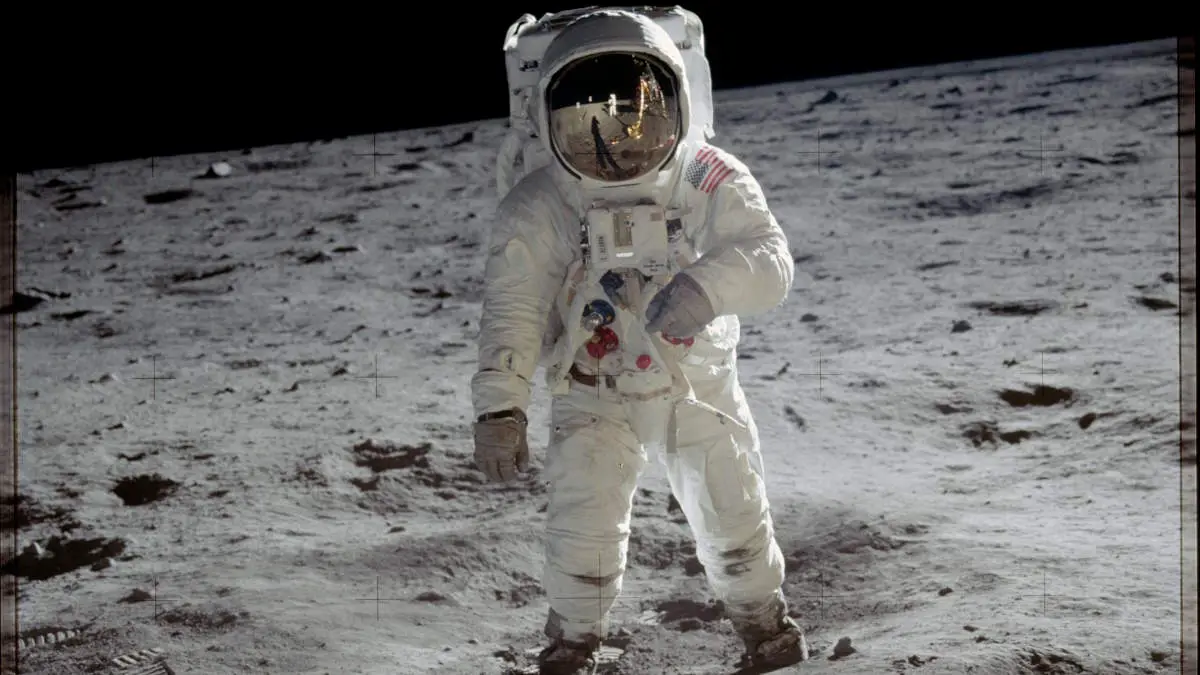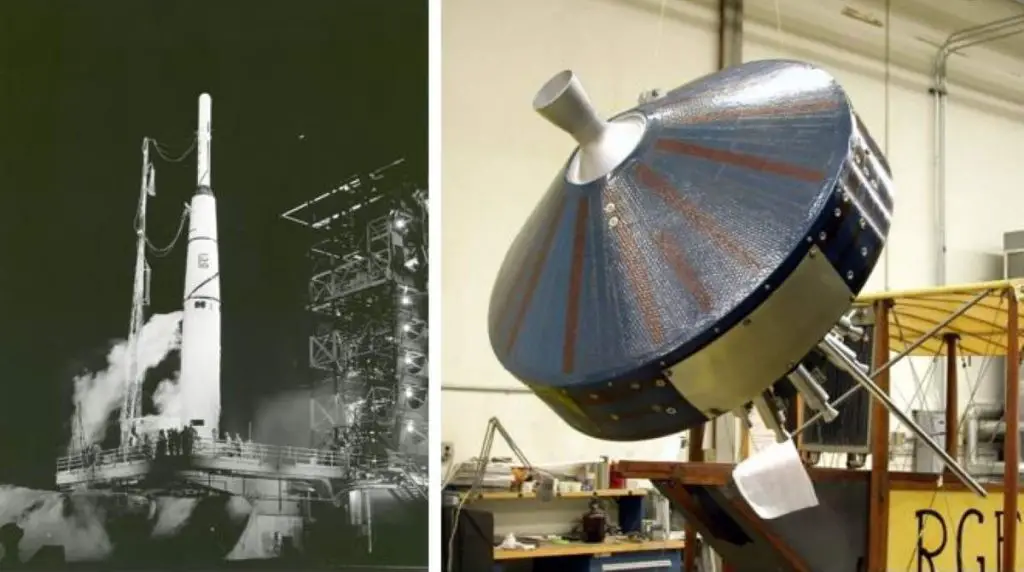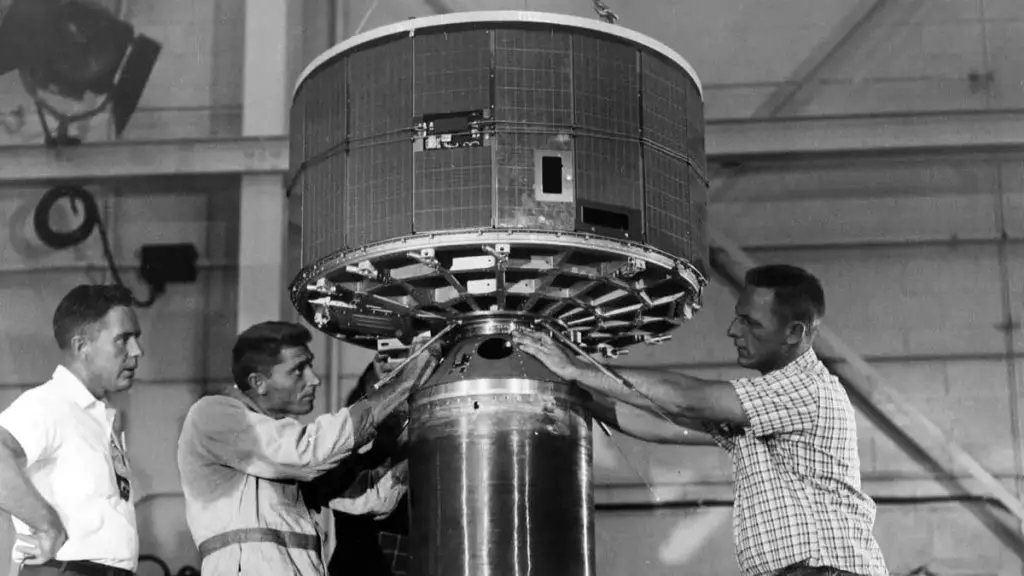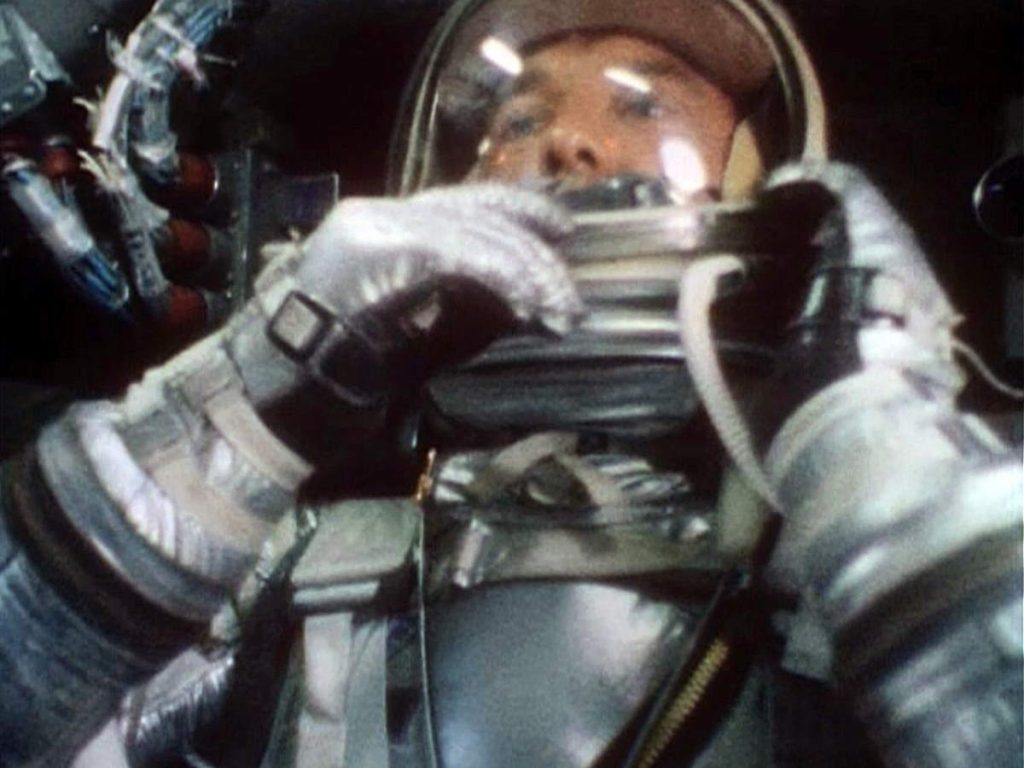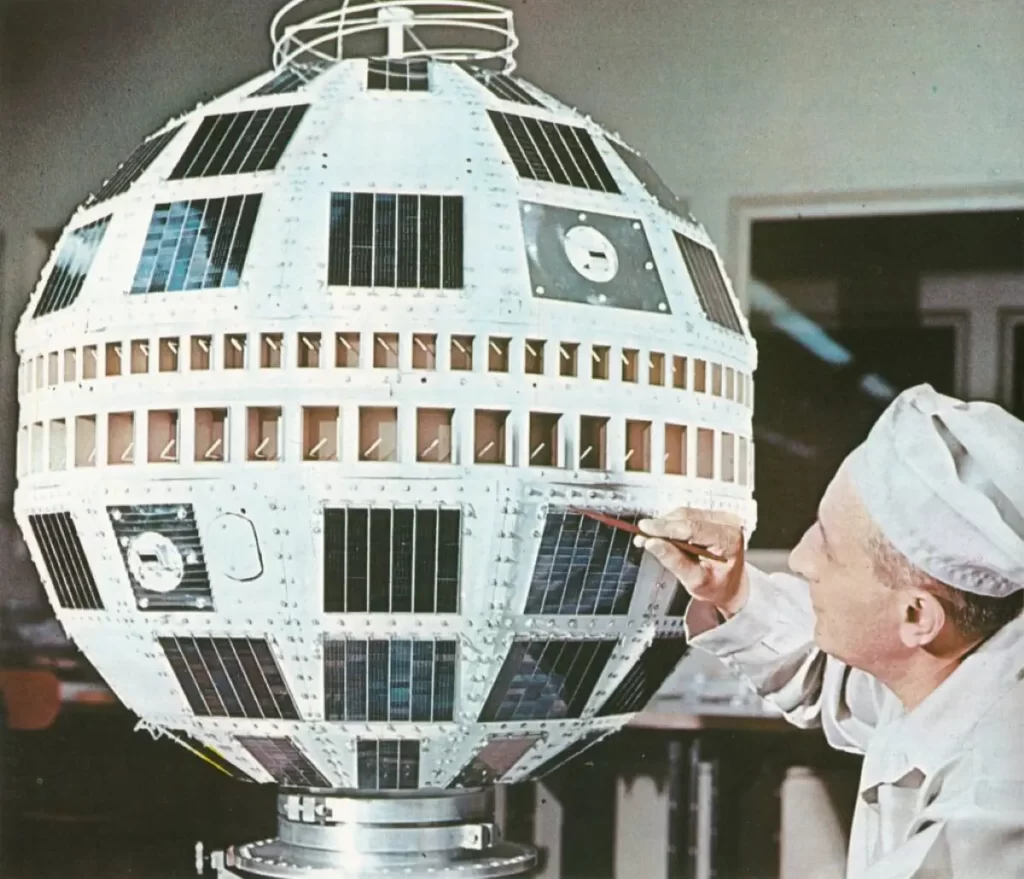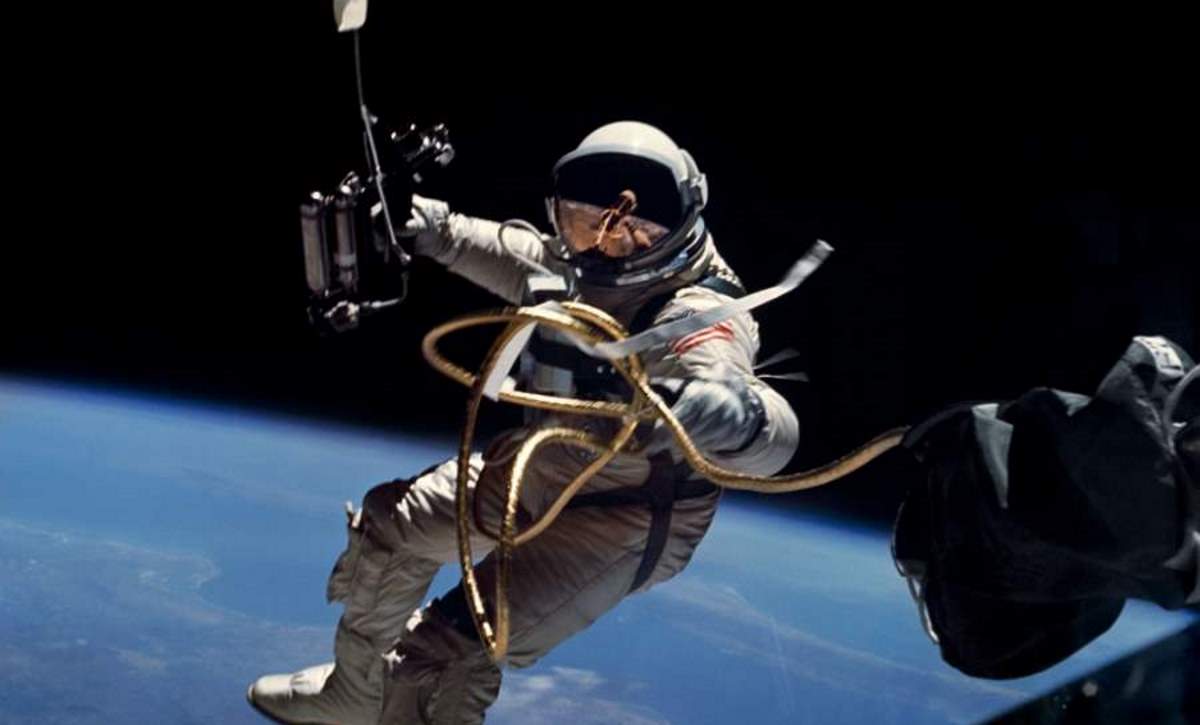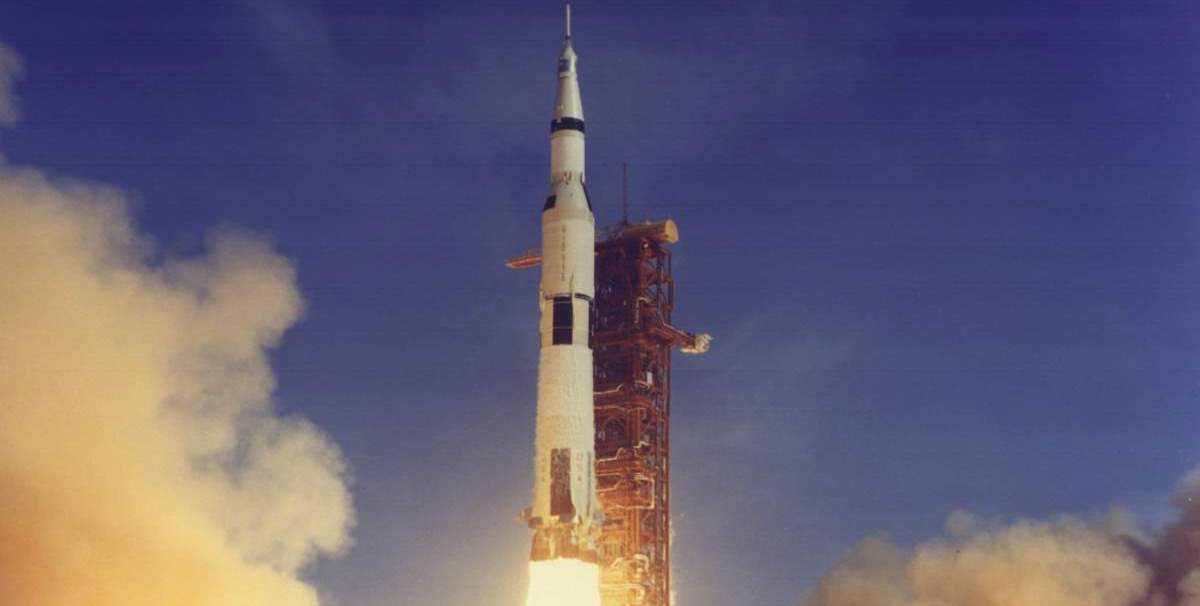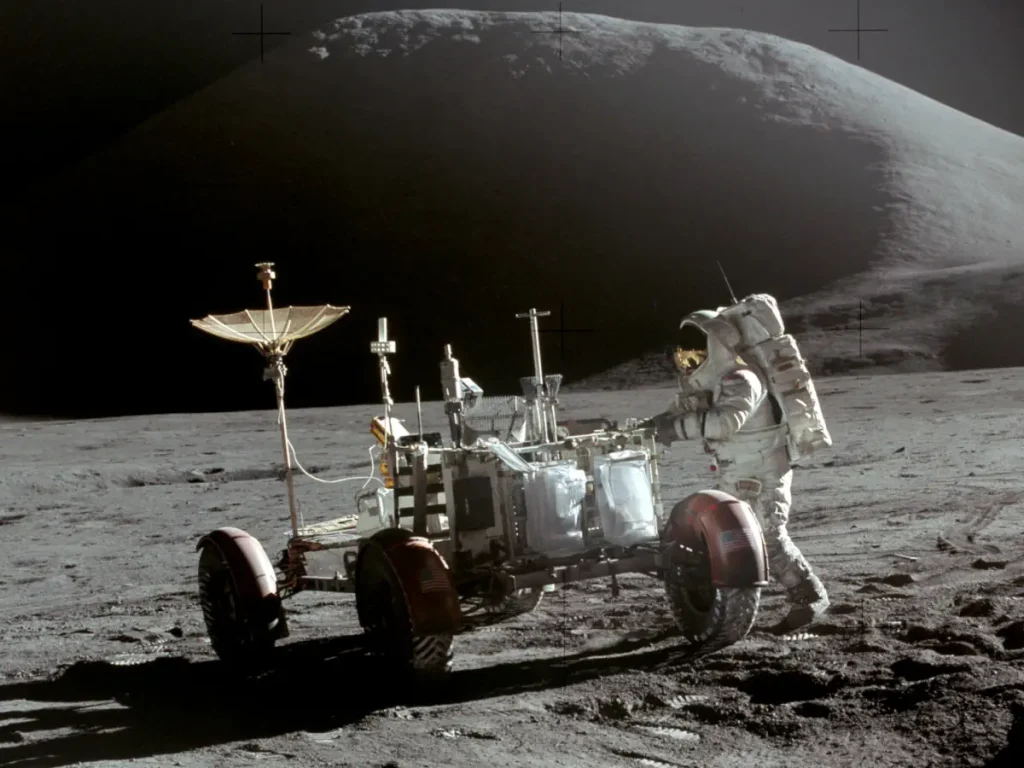The budget of NASA from 1958 to 1969 represents a crucial period in the history of space exploration. During these transformative years, NASA’s funding saw significant fluctuations, reflecting the national priorities and ambitions of the time. This period marked the inception of the Apollo program, leading to the landmark achievement of putting a human on the Moon in 1969. Additionally, other pioneering missions such as the Mercury and Gemini programs laid the groundwork for human spaceflight. This era also witnessed the launch of various scientific and exploratory satellites. In this article, we will delve into the year-by-year budgetary allocations and how they shaped these historic milestones.
Main Article: The budget of NASA from 1958 to 2024 [year by year]
The budget of NASA from 1958 to 1969 [year by year]
The numbers in square brackets [] are the budget of NASA adjusted for inflation (2023 equivalent).
1958: $88 million [$940 million]
The budget of NASA is 0.1% of the 1958 Fed Budget
Major achievements:
- October 11: Pioneer I was launched, becoming the first spacecraft launched by NASA.
- November 7: NASA research pilot John McKay made the last flight in the X-1E, the final model flown of the X-1 series. The plane was used to obtain in-flight data at twice the speed of sound.
- December 6: Pioneer 3 was launched, the first U.S. satellite to ascend to an altitude of 63,580 miles (102,322 km).
- December 18: The Air Force successfully launched a communications relay satellite, known as PROJECT SCORE or the “talking atlas,” into orbit using an Atlas booster. With a total mass of 8,750 pounds (3,969 kg), the payload itself weighed in at 150 pounds (68 kg). It was through this satellite that President Eisenhower’s Christmas message was broadcasted on December 19, marking the first instance of a voice transmission originating from space.
1959: $145 million [$1.516 billion]
The budget of NASA is 0.2% of the 1959 Fed Budget
Major achievements:
- March 3: The United States sent Pioneer 4 to the Moon, successfully making the first U.S. lunar flyby.
- April 9: NASA introduced the Original Seven Mercury astronauts to the public, who are commonly known as the “Mercury Seven”. With Project Mercury, the United States gained its first experience in conducting human space missions that provided scientific and engineering knowledge for astronauts in space.
- May 28: The United States launches and recovers two monkeys, Able and Baker, after launching in Jupiter nosecone during a suborbital flight (the first orbital flight where the first animals and plants returned alive from space performed by the Soviet Union on August 20, 1960). The flight was successful, testing the capability to launch from Cape Canaveral, Florida, and to recover spacecraft in the Atlantic Ocean, but Able later died. A suborbital flight refers to a journey where a spacecraft or vehicle is launched into space but does not achieve enough velocity to enter a stable orbit around the Earth. Instead, it follows a trajectory that reaches space but quickly returns to the planet’s surface. This type of flight allows for brief experiences of weightlessness and a glimpse of the curvature of the Earth.
- June 8: North American Aviation, Inc. research pilot Scott Crossfield made the first unpowered glide flight in the joint X-15 hypersonic research program NASA conducted with the Air Force, the Navy, and North American Aviation (NAA).
1960: $401 million [$4.130 billion]
The budget of NASA is 0.5% of the 1960 Fed Budget
Major achievements:
- April 1: TIROS 1 was launched. It was the first successful meteorological satellite, to observe Earth’s weather.
- April 13: Transit 1B, the first experimental orbital navigation system was launched.
- July 1: The first launch of the Scout launch vehicle. The Scout’s four-stage booster could place a 330-pound [150 kg] satellite into orbit, and it quickly became a workhorse in orbiting scientific payloads during the 1960s.
- August 12: NASA successfully launched Echo 1 into orbit, a passive communications satellite characterized by a 100-foot aluminized balloon. Its mission was to reflect radio beams, enabling long-distance communication. While this endeavor was indeed fruitful, it was soon overtaken by active-repeater communications satellites, notably Telstar.
- December 19: NASA launched Mercury 1, marking the debut of the Mercury-Redstone capsule-launch vehicle combination. This significant milestone represented an initial step in America’s crewed spaceflight program. This mission served as an unoccupied test flight, a necessary precursor designed to validate the safety and reliability of the system before astronauts embarked on their pioneering journeys into space.
1961: $744 million [$7.586 billion]
The budget of NASA is 0.9% of the 1961 Fed Budget
Major achievements:
- January 31: Mercury 2 was launched. It was a test mission of the Mercury-Redstone capsule-launch vehicle combination with the chimpanzee Ham (July 1957 – January 19, 1983) aboard during a 16.5-minute flight in suborbital space. Suborbital flight refers to a spaceflight in which the spacecraft reaches space, but its trajectory intersects the atmosphere or surface of the planet from which it was launched, so it doesn’t complete one full orbit. The spacecraft ascends to a certain altitude and then falls back to Earth along a parabolic path, similar to an object thrown into the air. These flights often reach the edge of space, allowing passengers a brief period of weightlessness and a view of Earth from space. Ham and his capsule are successfully recovered.
- May 5: The first U.S. spaceflight involving human beings: Freedom 7, the first piloted Mercury spacecraft (No. 7) carrying Astronaut Alan B. Shepard, Jr., was launched from Cape Canaveral by MercuryRedstone (MR3) launch vehicle, to an altitude of 115 nautical miles (213 km) and a range of 302 miles (456 km). During his 15-minute suborbital flight, Shepard rode a Redstone booster to a splashdown in the Atlantic Ocean. Shepard demonstrated that individuals can control a vehicle during weightlessness and high G stresses, and significant scientific biomedical data were acquired. He reached a speed of 5,100 mph (8,208 km/h) and his flight lasted 14.8 minutes. Shepard was the second human (after Yuri Gagarin) and the first American to fly in space.
- May 25: John F. Kennedy, the 35th president of the United States announced the Moon landing goal. He stood before Congress, and proposed that the United States “should commit itself to achieving the goal, before this decade is out, of landing a man on the Moon and returning him safely to the Earth.”
- July 21: NASA astronaut “Gus” Grissom embarked on the second crewed (piloted) mission of a Mercury spacecraft in a suborbital flight. This flight experienced complications when the hatch of the Mercury capsule, Liberty Bell 7, unexpectedly detached, causing the vessel to sink into the Atlantic Ocean before it could be saved. Grissom faced a near-drowning scenario, only narrowly escaping through a helicopter rescue. Despite these issues, these suborbital missions were extremely informative for NASA engineers, who identified and overcame an enormous number of challenges to make space flight successful.
1962: $1.257 billion [$12.661 billion]
The budget of NASA is 1.18% of the 1962 Fed Budget
Major achievements:
- February 20: A member of the Mercury Seven, John Glenn (July 18, 1921 – December 8, 2016) marked a significant milestone in American history by becoming the first American astronaut to orbit the Earth, completing three circuits aboard his spacecraft, Friendship 7 Mercury. Despite encountering several challenges, including an autopilot malfunction that required Glenn to manually control parts of the final two orbits, and the necessity to leave his typically discarded retrorocket pack attached during reentry due to a loose heat shield, this mission was a monumental success. Beyond acknowledging the impressive technological achievement, the public hailed Glenn as an embodiment of bravery and honor.
- July 10: NASA launched Telstar 1, the first privately built satellite (for communications). Two days after the launch, on July 12, it relayed the world’s first transatlantic television signal, from Andover Earth Station, Maine, United States, to the Pleumeur-Bodou Telecom Center, Brittany, France. The first images transmitted by Telstar 1, those of President John F. Kennedy and of singer Yves Montand from France, along with clips of sporting events, images of the American flag waving in the breeze, and a still image of Mount Rushmore, were precursors of the global communications that today are mostly taken for granted.
- October 3: NASA astronaut Wally Schirra (March 12, 1923 – May 3, 2007), one of the original seven astronauts chosen for Project Mercury, flew six orbits in the Mercury spacecraft Sigma 7.
- December 14: First successful planetary flyby – Launched on August 27, 1962, Mariner 2 became the first spacecraft to successfully encounter another planet, passing as close as 21,607 miles (34,773 kilometers) to Venus after 110 days of flight.
1963: $2.552 billion [$25.398 billion]
The budget of NASA is 2.29% of the 1963 Fed Budget
Major achievements:
- May 15-16: The pinnacle achievement of Project Mercury was realized with a historic flight crewed by astronaut L. Gordon Cooper (March 6, 1927 – October 4, 2004). Entrusted with the final and longest mission of the project, Cooper successfully orbited the Earth 22 times over 34 hours. His faithful companion for this audacious journey was the Mercury capsule named “Faith 7.” This monumental expedition not only marked a significant milestone in space exploration but also solidified the closing stages of Project Mercury, setting the stage for more advanced space endeavors.
- August 22: Experimental aircraft North American X-15 sets an altitude record of 354,200 feet (67 miles or 107.8 km). Piloted by Joseph A. Walker (February 20, 1921 – June 8, 1966), the aircraft successfully flew above the Kármán line. Named after the physicist Theodore von Kármán (11 May 1881 – 6 May 1963), the Kármán line is an internationally recognized boundary between Earth’s atmosphere and outer space. Situated approximately 100 kilometers (62 miles) above sea level, it is the point at which conventional aerodynamic principles give way to astronautics. Crossing this line is often considered the point where space begins, and has been used as the qualifying altitude for the recognition of astronaut status.
1964: $4.171 billion [$40.976 billion]
The budget of NASA is 3.52% of the 1964 Fed Budget
Major achievements:
- January 29: NASA’s largest launch vehicle to date, Saturn I SA-5, sends a record of 16,965 kg (37,401 lb) into orbit during a test flight.
- April 8: The first Gemini flight, Gemini 1 marked a significant step in NASA’s quest to land a human on the moon. This uncrewed test flight was designed to assess the spacecraft’s structural integrity and compatibility with the Titan II rocket. The mission was a success, achieving a stable orbit and reentering Earth’s atmosphere as planned, paving the way for future crewed Gemini missions. It served as a vital precursor to the subsequent achievements in human space exploration.
- May 28: NASA placed the first Apollo Command Module (CM) in orbit. This was the first uncrewed, orbital test flight of an Apollo Command Module. The AS-101 (also designated SA-6) flight was launched atop a Saturn I rocket from Cape Canaveral, Florida. The mission’s main objective was to test the structural integrity of the Apollo spacecraft during launch and to assess its compatibility with the Saturn I. Although this mission didn’t include a Service Module (the part of the spacecraft that would later provide life support and propulsion for Apollo missions), it was a crucial step in the development of the Apollo program.
- July 28: Ranger 7 was launched. It was part of NASA’s Ranger program, a series of uncrewed spacecraft launched in the early 1960s to obtain the first close-up images of the Moon’s surface. Ranger 7 was the first successful mission in this program. It was designed to achieve a lunar impact trajectory and to transmit high-resolution photographs of the lunar surface during the final minutes of flight up to impact. The spacecraft carried six television vidicon cameras – two wide-angle and four narrow-angle – to accomplish these objectives. These cameras started taking photographs 17 minutes before impact on July 31 and sent over 4,300 images back to Earth. These images provided a scientific treasure trove, giving researchers their first detailed look at the moon’s surface and helping to pave the way for future crewed lunar missions.
- October 30: NASA pilot Joseph Walker (February 20, 1921 – June 8, 1966) conducted the first flight in the Lunar Landing Research Vehicle (LLRV), known for its unusual shape as the “Flying Bedstead.” Two LLRVs and three Lunar Landing Training Vehicles developed from them provided realistic simulation that was critical for landing a spacecraft on the Moon in the Apollo program. The LLRVs also provided the controls design database for the lunar module.
1965: $5.092 billion [$49.232 billion]
The budget of NASA is 4.31% of the 1965 Fed Budget
Major achievements:
- March 23: Gemini III, the first crewed mission of NASA’s Gemini program. Commanded by veteran astronaut Gus Grissom (April 3, 1926 – January 27, 1967) and piloted by John W. Young (September 24, 1930 – January 5, 2018), it was a significant step towards the Apollo moon missions. The spacecraft, named “Molly Brown,” made three Earth orbits during its nearly five-hour flight. It marked the first time an American spacecraft’s orbit was changed during flight, demonstrating astronauts could alter their craft’s path, a crucial capability for lunar landings.
- April 5: Intelsat I, the first commercial satellite (communications), was launched into geostationary orbit.
- June 3-7: Gemini IV, the second crewed Gemini mission, commanded by James McDivitt (June 10, 1929 – October 13, 2022) and piloted by Edward H. White II (November 14, 1930 – January 27, 1967), marked the first American spacewalk. During the mission, White spent approximately 20 minutes outside the spacecraft, secured by a tether. The mission lasted four days, a significant increase over previous American flights, and included 62 orbits of the Earth. It allowed NASA to evaluate the effects of prolonged space travel on astronauts, setting the stage for future lunar missions.
- July 14: Launched on November 28, 1964, Mariner 4 spacecraft flew within 6,118 miles (9,846 km) of Mars after an eight-month journey. This mission provided the first close-up images of the red planet.
- August 21-29: The third crewed Gemini flight, Gemini V took place. Crewed by astronauts Gordon Cooper (March 6, 1927 – October 4, 2004) and Pete Conrad (June 2, 1930 – July 8, 1999), the mission lasted eight days, a duration record at the time. It broke the Soviet Union’s previous record set by Vostok 5 in 1963 (5 days). The objective was to test whether humans could live in space long enough for a lunar mission. It was also the first to use fuel cells for electrical power and to attempt a simulated rendezvous in space, vital steps towards achieving the goal of a moon landing.
- December 4-18: During the flight of Gemini VII, American astronauts Frank Borman (March 14, 1928 – November 7, 2023) and James A. Lovell (born March 25, 1928) set a duration record of fourteen days in Earth orbit that holds for five years.
- December 15-16: Gemini VI, officially known as Gemini VI-A took place. It was an important mission in NASA’s space program. Crewed by astronauts Walter M. Schirra (March 12, 1923 – May 3, 2007) Jr. and Thomas P. Stafford (born September 17, 1930), the main objective was to perform a rendezvous with Gemini VII, which was already in orbit. After launch, Gemini VI-A successfully maneuvered to a position just 30 centimeters (12 inches) away from Gemini VII, marking the first-ever space rendezvous. This maneuver proved critical for subsequent Apollo missions, particularly for lunar landings.
1966: $5.933 billion [$55.715 billion]
The budget of NASA is 4.41% of the 1966 Fed Budget
Major achievements:
- March 16: During the Gemini VIII mission, American astronauts Neil A. Armstrong (August 5, 1930 – August 25, 2012) and David Scott (born June 6, 1932) performed the first orbital docking. They docked their spacecraft to an uncrewed Agena target vehicle, becoming the first coupling of two spacecraft. This was a critical task to master before attempting to land on the Moon, a mission that required several dockings and undockings of spacecraft. However, a critical in-space system failure led to a rapid, uncontrolled spin, resulting in an emergency end to the mission. It was the first critical in-space system failure of a U.S. spacecraft that threatened the lives of the astronauts.
- June 2: Surveyor 1, an uncrewed spacecraft, made a successful soft landing on the lunar surface, becoming the first American spacecraft to soft-land on the Moon (On February 3, 1966, Soviet Union’s Luna 9 performed the first-ever soft landing on the lunar surface). Launched on May 30, Surveyor 1 descended on the region known as the “Ocean of Storms”, a site under consideration for future Apollo lunar landings. During its operational period, it transmitted over 10,000 photographs of high resolution, providing a detailed depiction of the Moon’s surface, thus greatly aiding in the planning of subsequent missions.
- July 3-6: Gemini IX mission. The mission was initiated following the launch of the substitute Augmented Target Docking Adaptor (ATDA). Astronauts Thomas P. Stafford (born September 17, 1930) and Eugene Cernan (March 14, 1934 – January 16, 2017) managed to rendezvous with the ATDA, however, a docking mishap occurred because the nose fairing of the docking target didn’t eject as intended, due to an error during launch preparation. Cernan performed a two-hour spacewalk with plans to demonstrate self-propelled flight using the USAF Astronaut Maneuvering Unit, a self-contained rocket pack. However, a combination of stress, exhaustion, and overheating prevented the completion of this task. Despite challenges, the mission contributed valuable learnings for future missions.
- July 18-21: Gemini X mission. Crewed by astronauts John W. Young (September 24, 1930 – January 5, 2018) and Michael Collins (October 31, 1930 – April 28, 2021), it was known for performing the first double rendezvous with two separate Agena Target Vehicles. The mission furthered the understanding of long-duration space flight and tested astronaut maneuverability in space. Collins conducted two spacewalks, retrieving experiments from the Agena and observing the stars. Despite some challenges, the mission significantly contributed to future Apollo program planning.
- August 10: The Lunar Orbiter Project has begun (it concluded on August 1, 1967). The project consisted of five uncrewed spacecraft designed to map the Moon’s surface in preparation for the Apollo missions. The orbiters photographed potential landing sites and provided detailed images of both the lunar near and far sides. They collectively transmitted over 3,000 high-resolution and medium-resolution photographs, greatly enhancing our understanding of the Moon’s geography. The successful project played a pivotal role in the selection of safe and scientifically interesting landing sites for human exploration.
- November 11-15: Gemini XII, the final mission of NASA’s Gemini program, was conducted in November 1966. Crewed by astronauts Jim Lovell (born March 25, 1928) and Buzz Aldrin (born January 20, 1930), it aimed to demonstrate rendezvous, docking, and extra-vehicular activities, vital for future Apollo missions. Aldrin performed three successful spacewalks, lasting a total of 5 hours and 30 minutes, implementing new techniques to combat astronaut fatigue. This mission also included experiments in docking, maneuvering, and station-keeping. Despite minor glitches, Gemini XII marked a successful end to the Gemini program, paving the way for the Apollo missions.
1967: $5.425 billion [$49.572 billion]
The budget of NASA is 3.45% of the 1967 Fed Budget
On January 27, 1966, a critical event unfolded during a simulation exercise for the Apollo-Saturn (AS) 204 mission (Apollo 1), located on the launch pad at Kennedy Space Center, Florida. After several hours of diligent work, a sudden flash fire erupted within the capsule’s pure oxygen environment. This conflagration quickly consumed the spacecraft, leading to the tragic asphyxiation of the three astronauts on board: Gus Grissom, Ed White, and Roger Chaffee. Before this catastrophe, the U.S. space program had lost three astronauts, all in unrelated plane crashes. However, this was the first time that deaths were directly linked to the space program itself.
This heartbreaking incident brought the Apollo program to a temporary standstill, necessitating a hiatus for an extensive review and redesign of the spacecraft to ensure the safety of future crews. After implementing crucial modifications and enhancements, the Apollo program resumed its crewed flight status with Apollo 7 in October 1968, marking a significant step forward in the pursuit of space exploration.
Major achievements:
- November 9: Apollo 4 was launched. It was the first uncrewed test flight of NASA’s mighty Saturn V rocket, which was used in the Apollo program to land astronauts on the Moon. This mission marked a significant milestone by successfully demonstrating the capabilities of the Saturn V, and it paved the way for successful lunar missions, including the historic Apollo 11 mission that put the first humans on the Moon.
1968: $4.722 billion [$41.373 billion]
The budget of NASA is 2.65% of the 1968 Fed Budget
Major achievements:
- January 22: Apollo 5, an uncrewed test mission in NASA’s Apollo program was launched. It was the first flight of the Lunar Module (LM), designed to land astronauts on the Moon. The mission tested the module’s ascent and descent engines, verifying their functionality in space for the first time. Despite some minor issues, Apollo 5 significantly contributed to the success of the subsequent crewed missions, including the historic Apollo 11 Moon landing.
- October 11-22: Apollo 7, the first crewed flight in NASA’s Apollo program took place. Astronauts Wally Schirra (March 12, 1923 – May 3, 2007), Donn Eisele (June 23, 1930 – December 1, 1987), and Walter Cunningham (March 16, 1932 – January 3, 2023) orbited the Earth for 11 days, testing the Command and Service Module (CSM) systems. Despite some tensions between the crew and ground control, the mission was a success, providing confidence in the Apollo hardware and paving the way for the subsequent Moon missions. It marked the return of crewed US spaceflights following the tragic Apollo 1 fire.
- December 21-27: Apollo 8, the first mission to orbit the Moon took place. was a pivotal mission in NASA’s Apollo program that achieved a series of significant space exploration firsts. Launched on December 21, 1968, it carried astronauts Frank Borman (March 14, 1928 – November 7, 2023), Jim Lovell (born March 25, 1928), and Bill Anders (born 17 October 1933) and was the first crewed spacecraft to leave Earth orbit, reach the Moon, orbit it, and return safely. The mission lasted 6 days and 3 hours. The astronauts became the first humans to witness and photograph an Earthrise over the lunar horizon. Apollo 8’s successful mission was a major step towards achieving the goal of landing a man on the Moon, boosting public enthusiasm and demonstrating the feasibility of the upcoming Apollo 11 mission. Its Christmas Eve broadcast, reading from the Book of Genesis, remains one of the most-watched TV broadcasts in history.
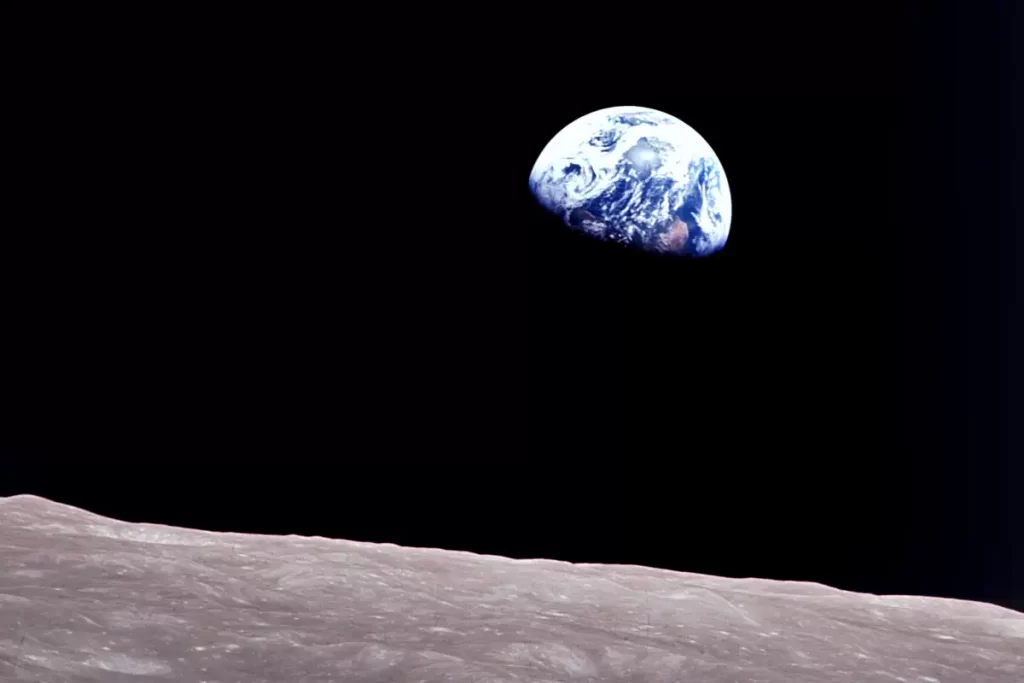
Related: Apollo 8 – The Daring Adventure
1969: $4.251 billion [$35.320 billion]
The budget of NASA is 2.31% of the 1969 Fed Budget
Major achievements:
- March 3-13: The Apollo 9 mission took place. It was the third crewed mission in NASA’s Apollo program. Astronauts James McDivitt (June 10, 1929 – October 13, 2022), David Scott (born June 6, 1932), and Russell Schweickart (born October 25, 1935) spent ten days in low Earth orbit testing the Lunar Module in preparation for the upcoming Apollo 11 mission. It was the first flight of the full Apollo spacecraft, both the Command and Service Module (CSM) and the Lunar Module (LM), with the crew performing the first crewed flight of the LM and the first docking of two vehicles in space.
- May 18-26: Apollo 10 mission. It was the second crewed mission to orbit the Moon and served as a “dress rehearsal” for the historic Apollo 11 mission. Launched on May 18, 1969, the crew consisted of astronauts Thomas Stafford (born September 17, 1930), John Young (September 24, 1930 – January 5, 2018), and Eugene Cernan (March 14, 1934 – January 16, 2017). The mission’s goal was to test all procedures, without actually landing, that would be used in the subsequent Apollo 11 mission. The Lunar Module, nicknamed “Snoopy,” descended to just 8.4 nautical miles (16 km) above the lunar surface before rejoining the Command Module, “Charlie Brown.” The mission’s success paved the way for the first crewed Moon landing.
- July 16-24: The Apollo 11 mission put the first humans on the Moon. It was crewed by astronauts Neil Armstrong (August 5, 1930 – August 25, 2012), Buzz Aldrin (born January 20, 1930), and Michael Collins (October 31, 1930 – April 28, 2021). After traveling for four days, Armstrong and Aldrin descended in the Lunar Module “Eagle” to the Moon’s surface, where Armstrong famously declared: “That’s one small step for man, one giant leap for mankind.” Meanwhile, Collins orbited above in the Command Module. After spending a little over 21 hours on the lunar surface and collecting 47.5 pounds of lunar material, the astronauts returned to Earth, splashing down in the Pacific Ocean on July 24. The success of Apollo 11 changed the face of space exploration forever.
- November 14-24: Apollo 12, the second crewed mission to land on the Moon took place. Astronauts Pete Conrad (June 2, 1930 – July 8, 1999), Alan Bean (March 15, 1932 – May 26, 2018), and Richard Gordon (October 5, 1929 – November 6, 2017) were the crew members. Despite a lightning strike at the Saturn V rocket during launch, the mission proceeded successfully. Conrad and Bean landed on the Moon’s Ocean of Storms, exploring the lunar surface and conducting experiments, while Gordon orbited above in the Command Module. They also retrieved parts from the Surveyor 3 probe, which had landed on the Moon two years prior, providing valuable insights into the lunar environment’s effects on man-made materials. The mission concluded with a successful splashdown on November 24.
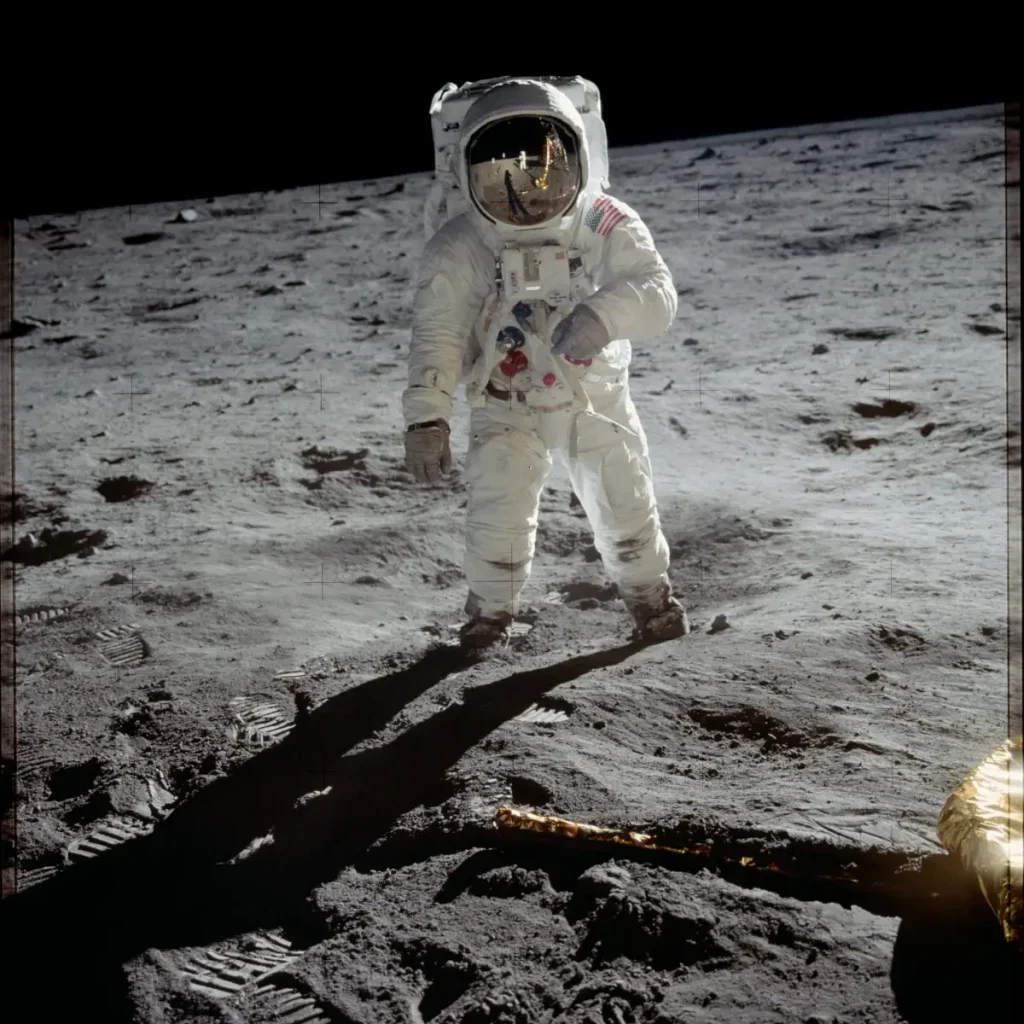
Sources
- Your Guide to NASA’s Budget on the Planetary Society website
- A Chronology Of Defining Events in NASA History on the NASA History website
- Budget of NASA on Wikipedia
- Moon Landings: All-Time List [1966-2025] - February 2, 2025
- What Is Max-Q and Why Is It Important During Rocket Launches? - January 16, 2025
- Top 10 Tallest Rockets Ever Launched [2025 Update] - January 16, 2025
